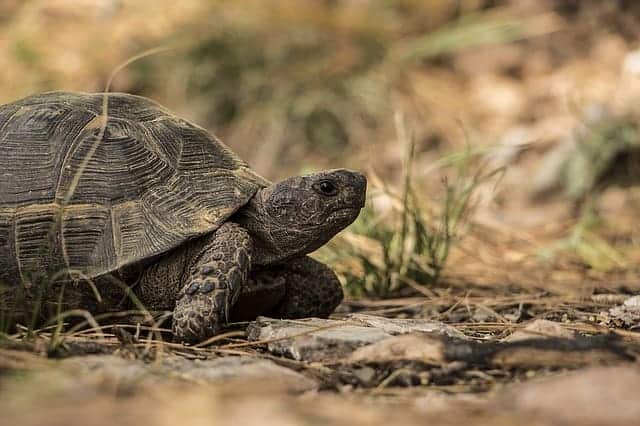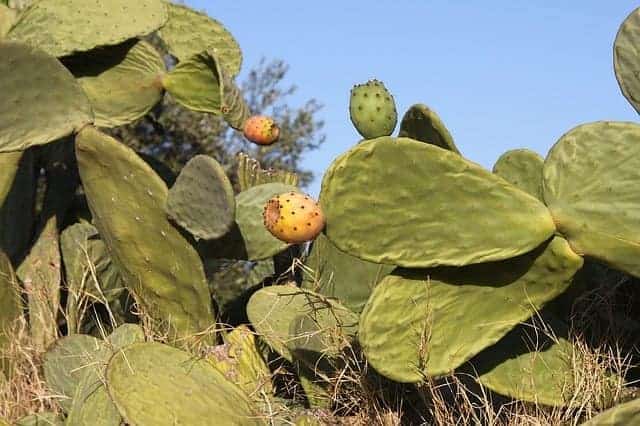
As tortoise owners we learn pretty quickly how important it is to include calcium in the diet of our pets. It’s a vital component in the metabolic process that ensures healthy bone and shell development, and without it a tortoise can suffer serious health complications ranging from soft shell syndrome to pyramiding.

To ensure sufficient calcium is absorbed by captive tortoises most owners provide supplementary calcium in addition to the calcium naturally found in their diet. This begs the question however; where do tortoises get their calcium from in the wild?
In short tortoises obtain calcium from a number of sources in the wild, including vegetation rich in calcium, such as certain leafy green vegetables like collard greens or kale. They may also obtain calcium from discarded bird eggs and snail shells, and naturally occuring chalk or limestone outcrops.
Naturally Occurring Plants (and Suitable Substitutes You Can Use at Home) That Contain Calcium
The exact plants a tortoise will come across in the wild will of course depend on which part of the world a particular species comes from. Mediterranean species for example live in semi arid grasslands, and will typically graze on the grasses and shrubs found in such environments.
Grasses can certainly form part of your own tortoise’s diet, however there are other plants that are more nutritionally rich that should be included in your own tortoise’s diet as well.
Prickly Pear is a type of cactus found in the natural habitat of mediterranean tortoises (Southern Europe and North Africa) as well as the deserts of north america, the natural habitat of desert tortoises and certain box turtle species. This plant contains a relatively high concentration of calcium (56mg per 100g), as well as being an excellent source of other nutrition and hydration in general.

It’s certainly possible to grow prickly pear in your own backyard, and if you’re prepared to put the effort in with poly tunnels or greenhouses if you live in a colder part of the world, it is certainly well worth it to give your tortoise one of the best sources of calcium, and indeed other nutrients and minerals they can consume.
My own plant of choice to feed my tortoise is dandelion, although being native to northern Europe, I’m not sure how often tortoises come across this plant in the wild. None the less dandelion is another great source of calcium, containing even more (187mg) of calcium per 100g than prickly pear.
If you grow your own plants specifically for the purposes of feeding your tortoise, a top tip is to sprinkle the soil with some sort of calcium based powder (whether crushed up cuttlebone, commercially avaiable calcium supplement, or even limestone flour which is designed to aid the digestion of horses!). This will enrich the soil and ultimately the plants that grow in it with more calcium than they might otherwise have.
Naturally Occuring Animal Sources of Calcium (and Suitable Substitutes You Can Use at Home)
In the wild it’s pretty much a case of anything goes in order to survive, and for a tortoise that needs to take on calcium this can come in several forms, even the carcusses of deceased creatures.
Snail shells are an obvious source, but the skeletal remains of other animals such as rodents may also be eaten. It’s worth bearing in mind that tortoises will sometimes eat carrion (the flesh of dead animals) although this isn’t typical of a tortoise’s diet, so isn’t generally something you should try to replicate in captivity.

The only real exception is south american red foot and yellow foot tortoises, who do benefit from a small amount of animal protein, however this still doesn’t amount to much more than the occasional small portion.
Back to calcium though, it isn’t really practical to feed your tortoise the skeleton of a small animal, but one readily available, not to mention tried and tested source of calcium of animal origin is cuttlefish bone, or ‘cuttlebone’.
I’ve no idea whether any tortoises based near to coastal regions actually come across cuttlebone in the wild, but if they do they will almost certainly take advantage of it as a source of calcium carbonate. The great thing about cuttlebone is that it exists in a soft and brittle form that is easy for a tortoise to bite into.
Alternatively you can crush up cuttlebone into a powder as use it in the same way as commercially available calcium supplements. Check out this great video for more information on that:
Sea shells offer similar benefits, although they are a much harder form of calcium carbonate, and should be crushed into a powder before being provided to your tortoise.
Naturally Occurring Stone/Mineral Sources of Calcium (and Suitable Substitutes You Can Use at Home)
Besides plants and animals the other primary source of calcium a tortoise will encounter in the wild is in the form of naturally occurring rock formations, particularly chalk or sandstone, which form as a result of animal decay over many millions of years.
Tortoises may lick rocky outcrops or chew on small rocks as they occur naturally, however it is best to make life easier for them in captivity by providing a similar substance in powdered form that can be sprinkled over their food.
I prefer a pure calcium carbonate powder supplement as this most closely resembles what would be found naturally. Other supplements are available that contain other substances, however whether or not these are 100% healthy in combination with one another is a subject of great contention.
How Often Do Tortoises Deliberately Consume Calcium in the Wild
Besides the calcium naturally found in the plants they eat, tortoises like most other animals that require calcium supplementation such as poultry, will consume calcium only when they need it. From experience this seems to be pretty infrequent – my tortoise for example has nibbled on his cuttlebone only a few times in the 4 years I have had him.
However for young tortoises in particular calcium is vital for the growth of a healthy shell and skeleton. Older specimens only need maintain what they already have, and therefore have less need for high doses of calcium.
To ensure a juvenile tortoise gets enough calcium I recommend sprinkling a good dusting of calcium carbonate powder over their food two or three times per week.
The consensous among many owners is that it isn’t possible to overfeed a juvenile tortoise calcium, so you don’t need to worry about overdoing it, and indeed if your tortoise gets too put off by the bitter taste of calcium carbonate they will eventually stop eating it anyway.
A higher dose of calcium is also required for a pregnant (or ‘gravid’) female tortoise because naturally she has both the shells of hatchling tortoises growing inside her, as well as the shells of the eggs they are growing in. So if you have, or suspect you have a pregnant female, be sure to up her calcium supplementation for the duration that she is carrying her eggs.


